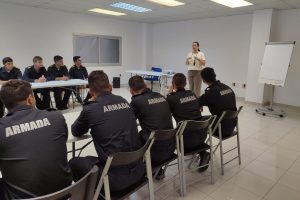As part of the specialized training in the industrial field of future Navy officers, 30 students of the fourth year (GGMM 2) of the Bachelor Degree in Mechanical Engineering taught at the Defense University Center at the Spanish Naval Academy (CUD-ENM) visited, last Thursday July 4th, 2024, the facilities of the company Wärtsilä Ibérica SA located in Porriño (Pontevedra) accompanied by the professors Mr. Carlos Pérez Collazo and Ms. Leticia Pérez Rial.

The Wärtsilä Group develops technologies and solutions for the marine and power markets (combined heat and power plants and the oil and gas industry). Its main customers include navies from different countries. The plant visited is dedicated to the design, manufacture and repair of bearings, ball bearings, couplings and tail shafts, among other elements necessary for the propulsion of a ship.

In the approximately two hours that the visit lasted, the students, after an initial talk on safety and risk prevention, had the opportunity to visit different areas of the plant. First of all, the production workshop was visited, where the students went through the different machining lines, where they could see the application of concepts covered in Fundamentals of Manufacturing Systems and Technologies and in Naval Machines and Engines. Part of the attention was focused on laser coating technologies (proprietary technologies patented by the company) and those related to anti-friction materials. The development of these robotic manufacturing processes using laser technology has enabled Wärtsilä to reduce its production costs and successfully enter new markets, such as wind turbine bearings.
Afterwards, the 2nd GGMM visited the Engineering and Product Development department. In this context, it was explained how some of the conditioning factors of the company’s business model lie in the development of technological solutions adapted to the customer’s needs in the different fields of action. Thanks to this approach, the company’s developments can be customized to meet the design of specific vessels and their operational needs. In this regard, the example was given of the technical requirements for the support bearings of a shaft line designed for integration into a submarine.
The visit ended with a commemorative photo of all participants.
